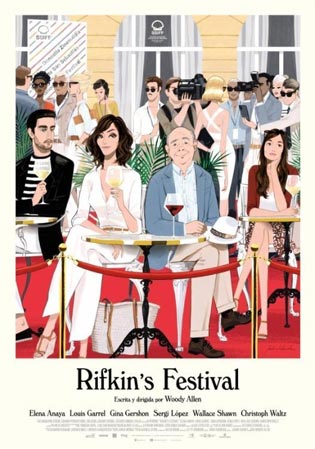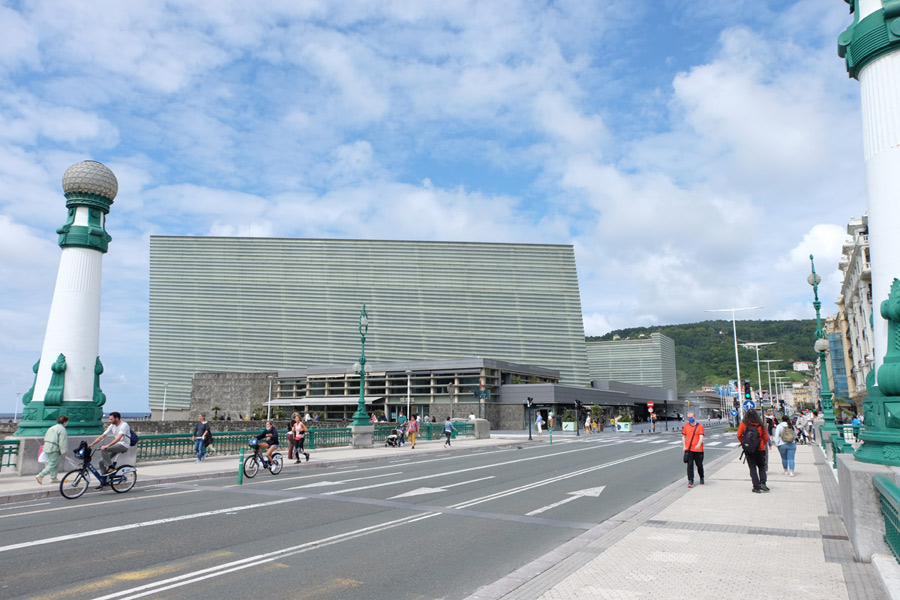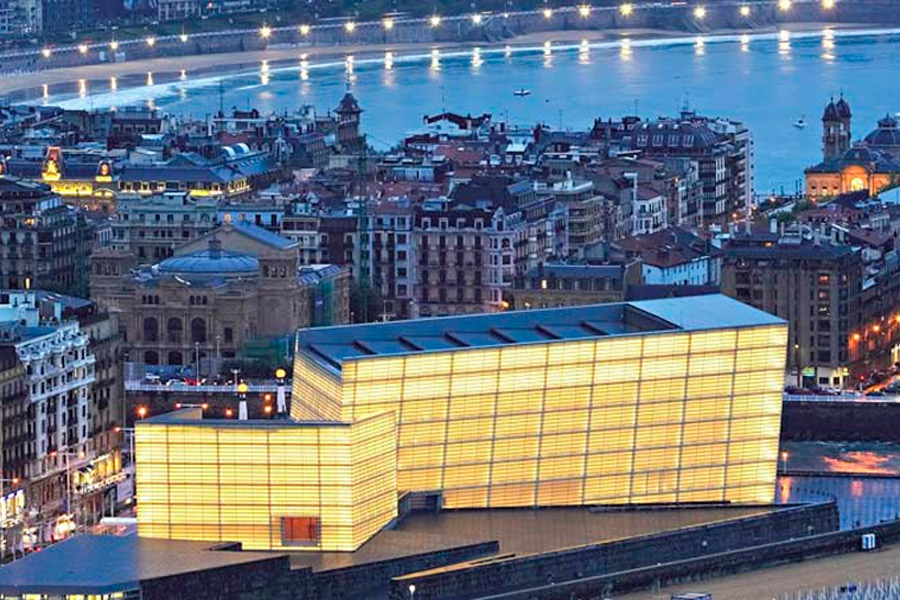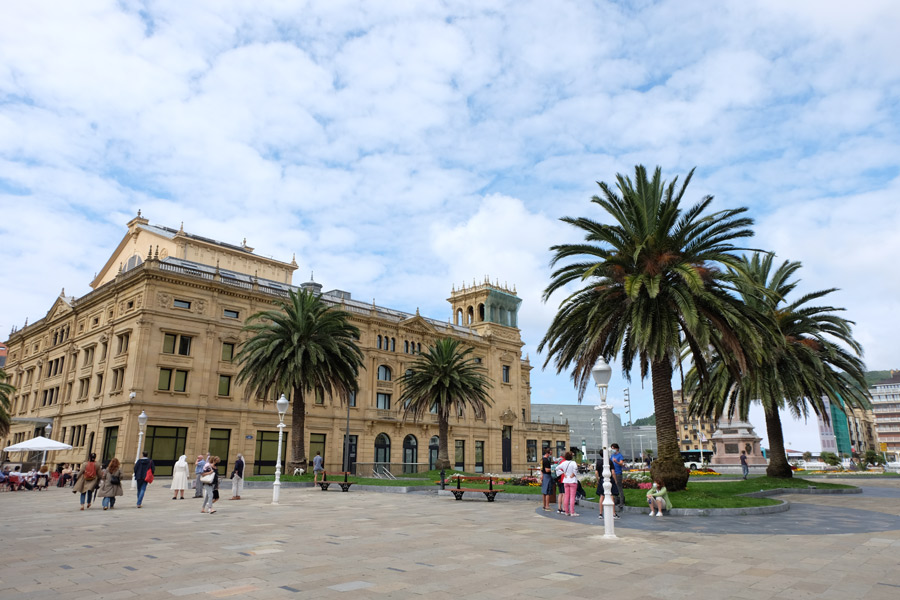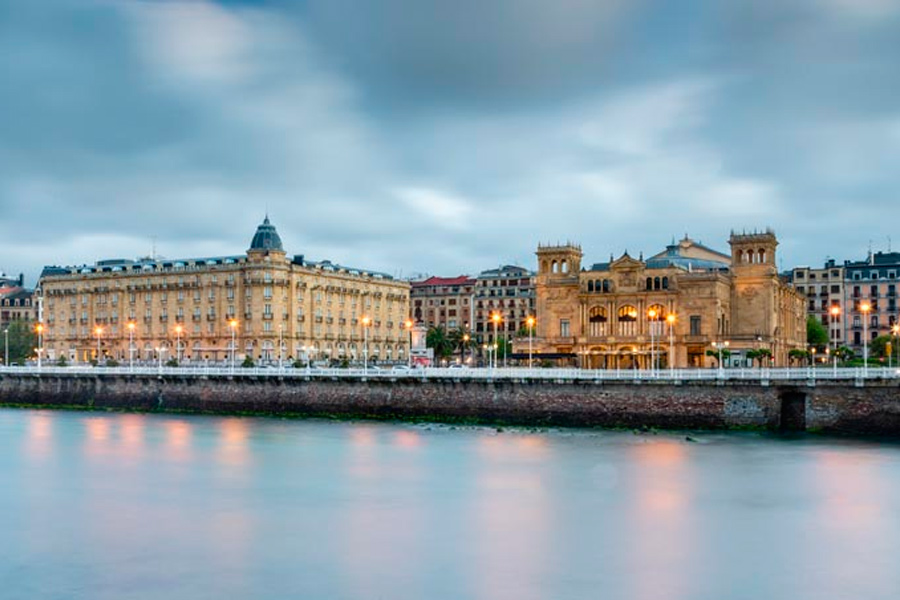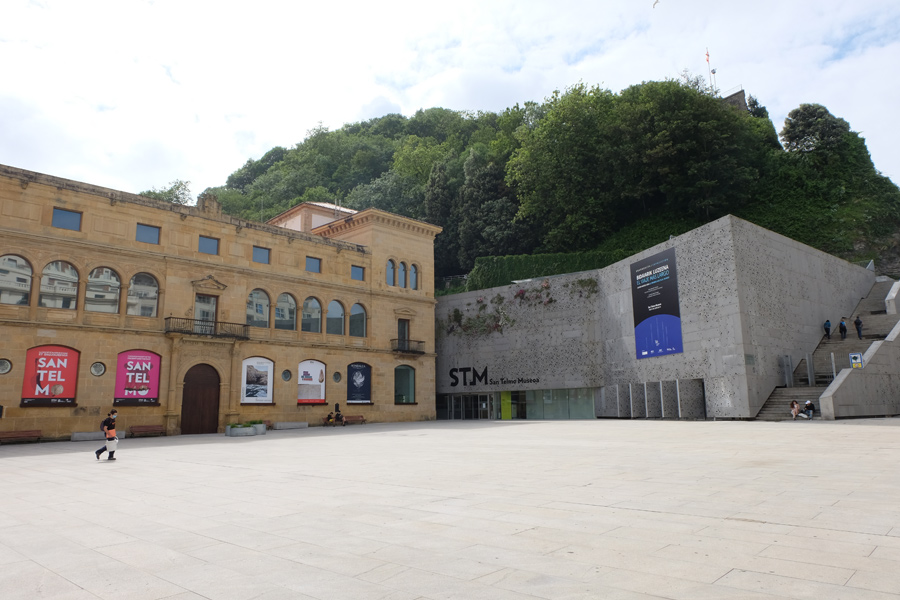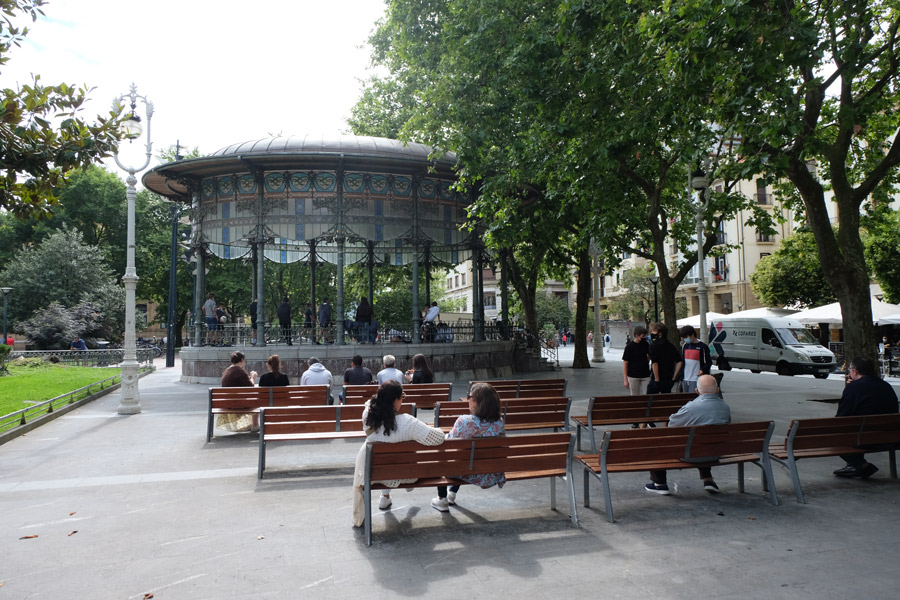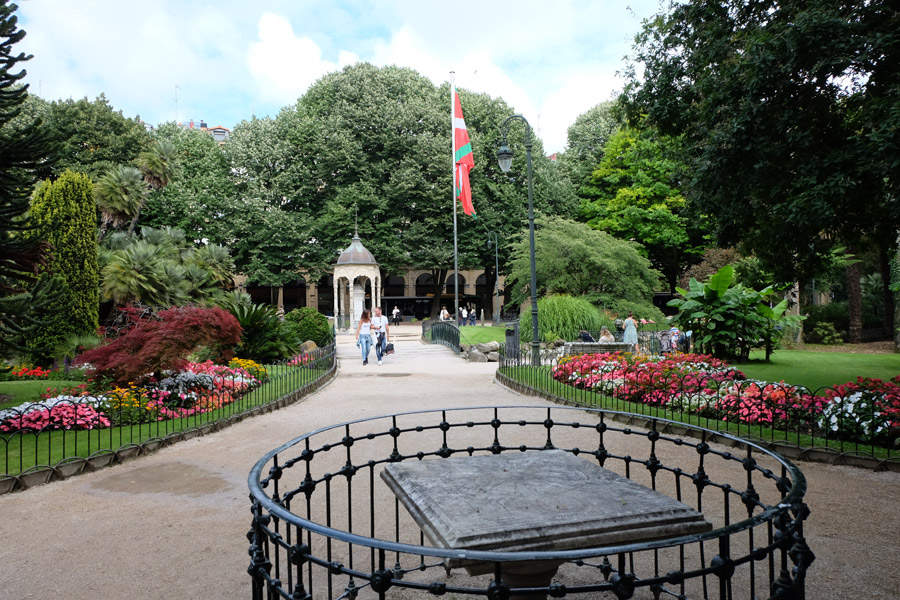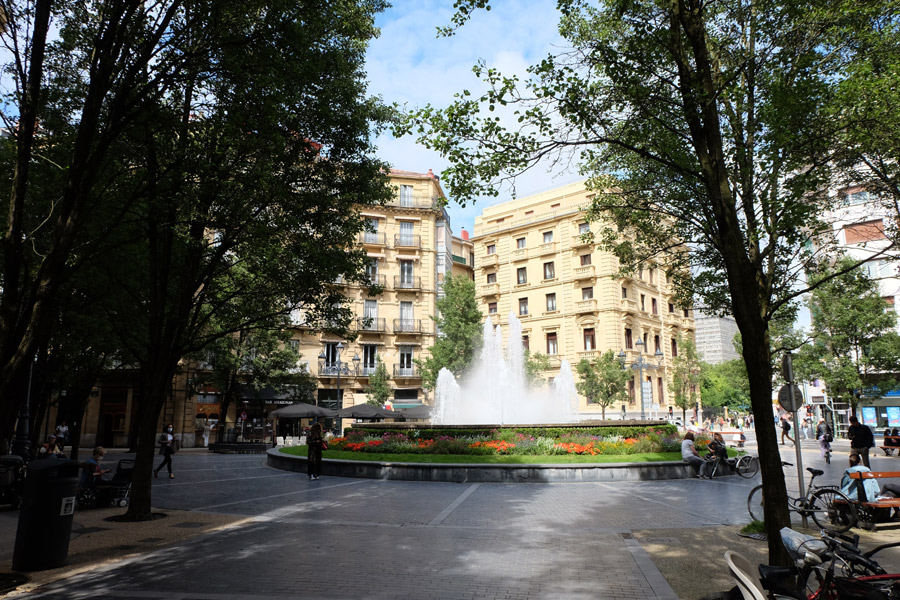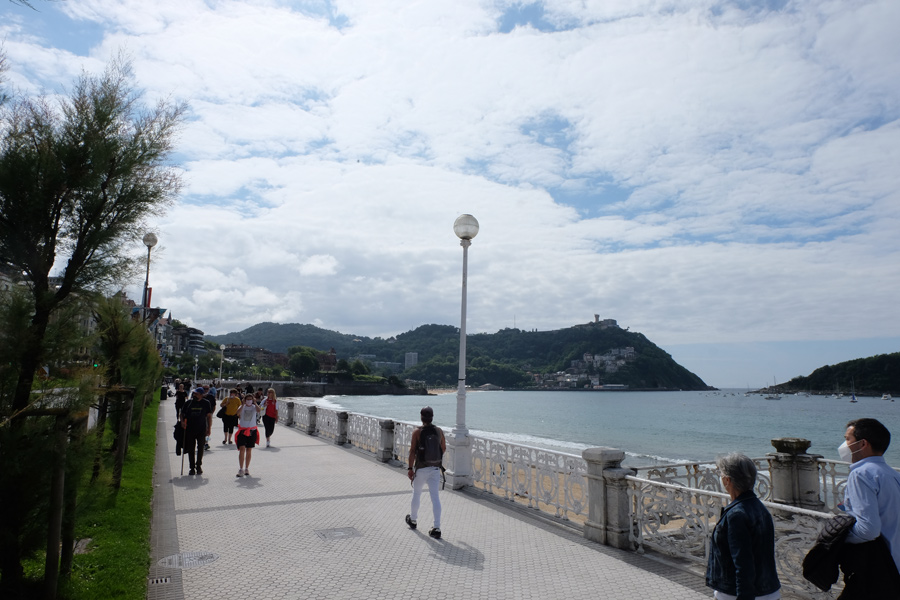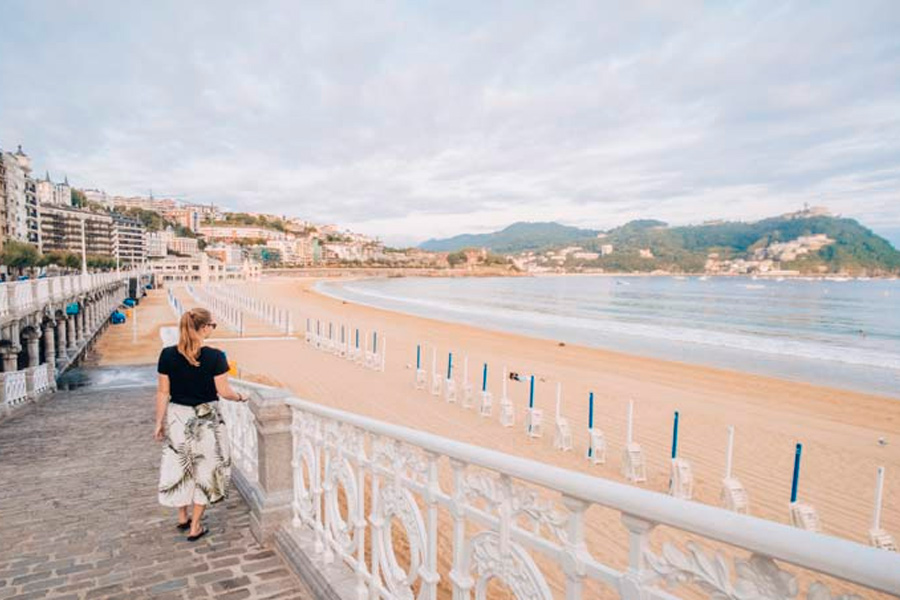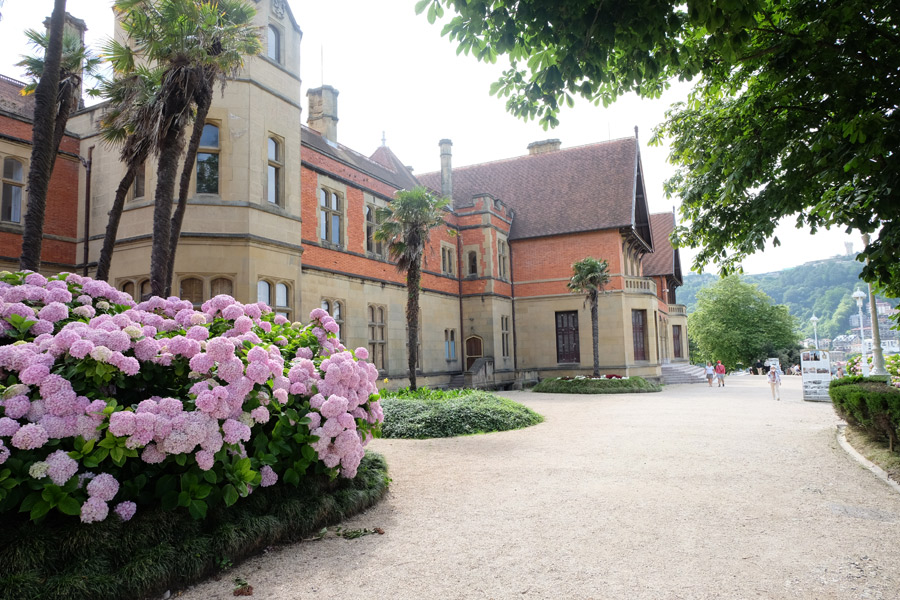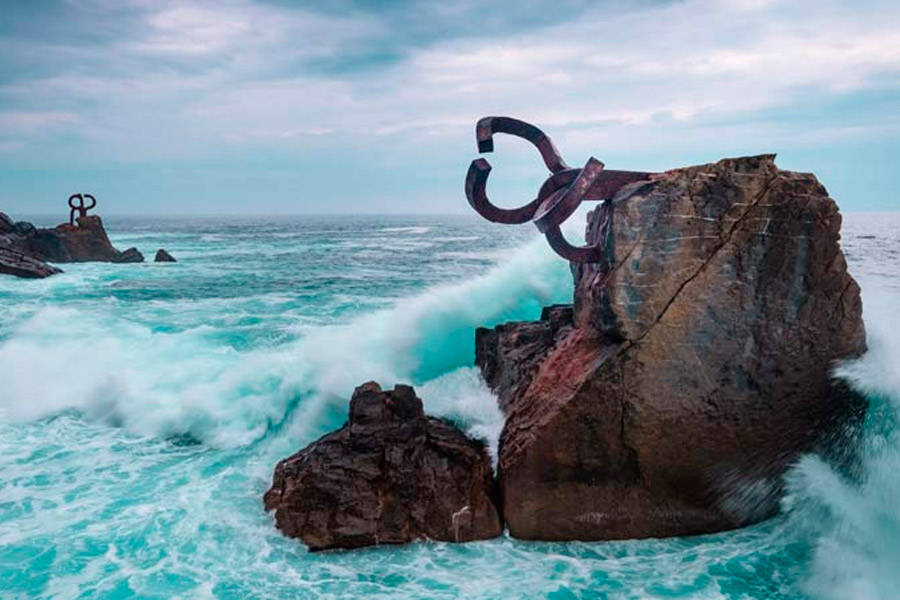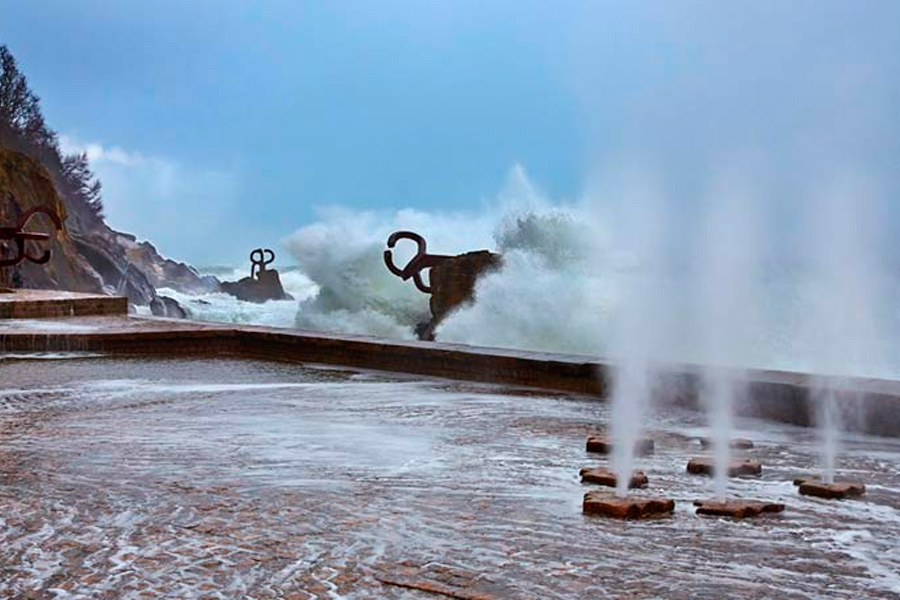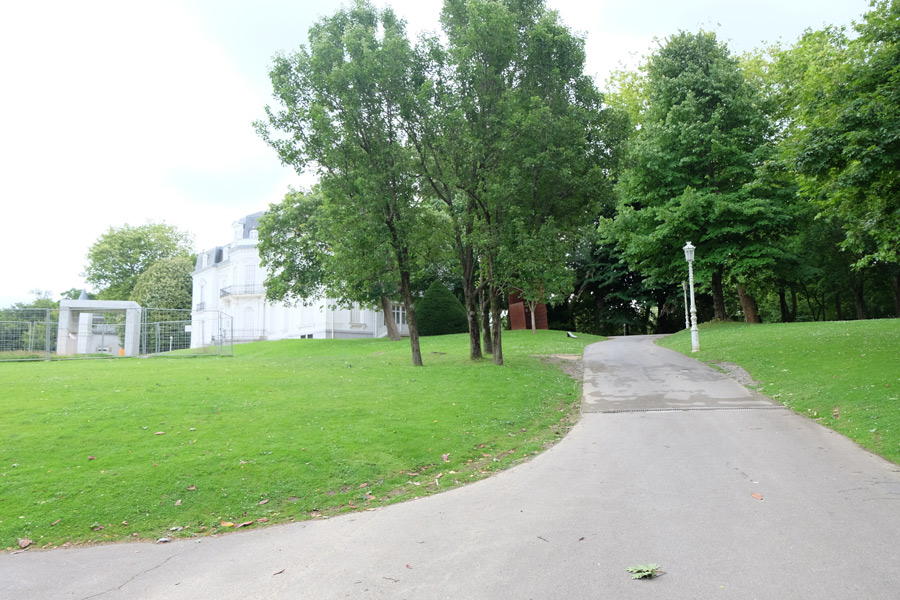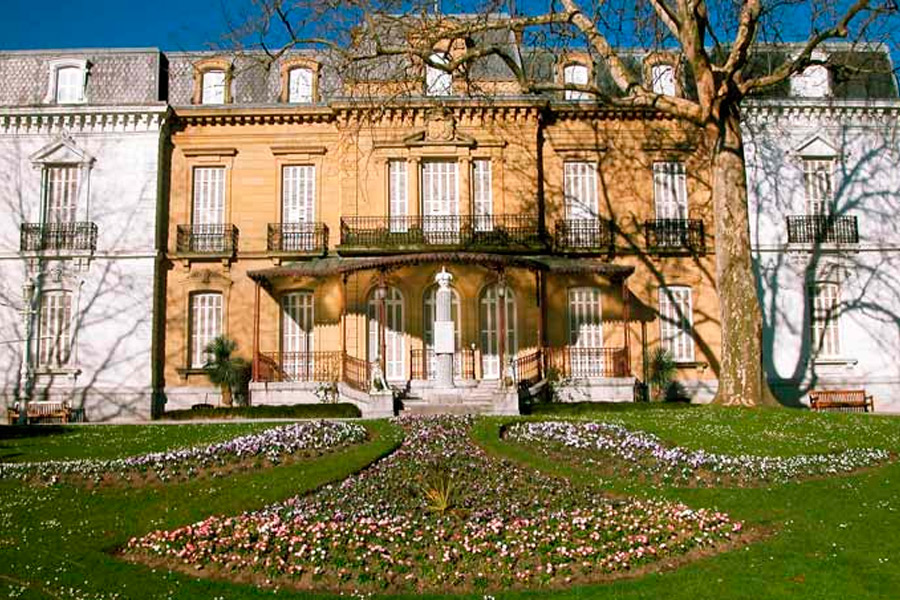Summary
Revisit the scenes in Rifkin's Festival on an interactive walking tour that hits some of the city’s most iconic spots, by visiting 10 key points.
- Distance: 8,3 kilometres
- Stops: 10
- Time: 2,5 hours
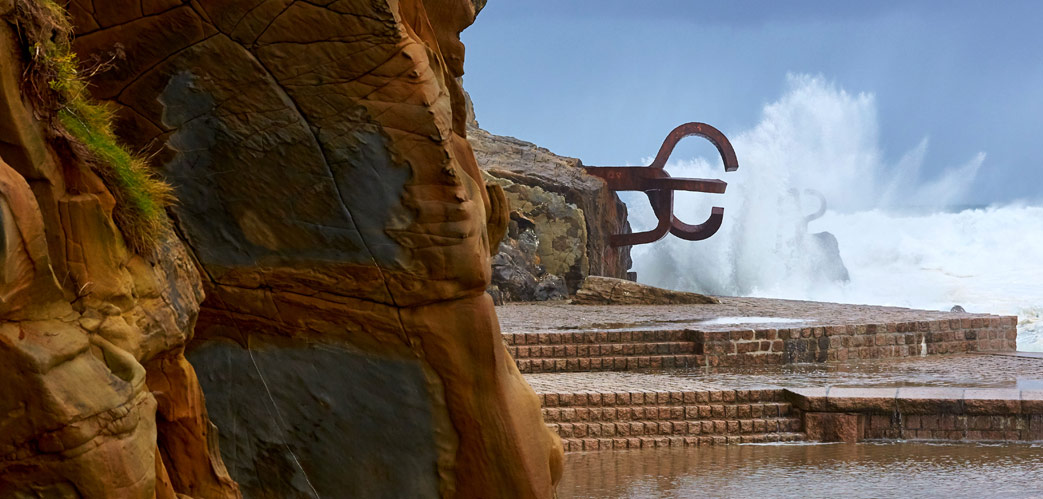
Itinerary
Next, we propose a tour in which you will be able to discover the locations in which the scenes of the film take place and get historical information of interest about each one of them.
- Kursaal Centre
- Plaza Okendo - Hotel María Cristina - Victoria Eugenia
- Plaza Zuloaga - Museo San Telmo - Church San Vicente
- Kiosko del Boulevard - Altxerri Jazz Bar
- Plaza Gipuzkoa - Provincial Council of Gipuzkoa
- Plaza Bilbao - María Cristina bridge - Paseo Árbol de Gernika
- La Concha promenade
- Miramar Palace
- El Peine del Viento (The Wind Comb)
- Aiete Palace
1. Kursaal Centre
Location of Kursaal Centre
The tour kicks off at the Kursaal Centre, the main venue of the San Sebastián International Film Festival (Donostia Zinemaldia in Basque) in both the film and real life. The film reproduces the atmosphere of the Festival: production designer Alain Bainée (Vicky Cristina Barcelona) and costume designer Sonia Grande (Midnight in Paris) tried to recreate the festival down to the smallest detail to lend a sense of credibility to the story, although the logos were altered, and the posters had to be created from scratch. “It was a lot of fun trying to make everything as realistic as possible, even though it was all made up”, Bainée said.
The avant-garde Kursaal Centre is, without a doubt, one of the city's landmarks. Did you know that this conference centre designed by architect Rafael Moneo won the European Union Prize for Contemporary Architecture-Mies van der Rohe Award in 2001? This unique building was designed to represent “two beached rocks”, highlighting the surrounding geography and the harmony between the natural and the artificial.
There are two filming locations that you can see from the vantage point of the Kursaal: the Zurriola Bridge (1921) with its striking Art Deco style street lights—which are also part of the Festival's props in the film—and the Michelin-starred Mirador de Ulia restaurant. The restaurant hosts one of the gala dinners in the film, with a spectacular view of the city in the background. It is also located on Mount Ulia, one of the best hiking spots in the city. So, if hiking is your thing, take note: you've now got plans for another day!
2. Plaza Okendo - Hotel María Cristina - Victoria Eugenia
You can see the historic and glamorous Hotel María Cristina, the hotel where the characters stay and which plays a major role in the film, from Plaza Okendo. Allen's family first stayed in a house in Igeldo while the film was being shot, but then they switched to the Maria Cristina, a decision they didn’t regret!
The hotel, which opened its doors in 1912 and was designed in the style of the Belle Époque, is the main hotel where the characters who come to attend the San Sebastian International Festival stay. Celebrities including Mata Hari, Coco Chanel, Audrey Hepburn, Alfred Hitchcock, Bruce Springsteen and Steven Spielberg have stayed there.
The Victoria Eugenia Theatre is located opposite the María Cristina, one of Spain's leading and most active theatres. Also inaugurated in 1912, its century of history has seen world premieres of films, including Hitchcock's Vertigo and North by Northwest, and has become the epicentre of Donostia's cultural life and festivals, and is also one of the venues of Zinemaldia. In this location we find a nod to Hitchcock's cameos, with José Luis Rebordinos and Lucía Olaciregui, director and assistant director of Zinemaldia, respectively, appearing as extras in Allen's film.
If you feel like making a quick stop to grab a drink, the popular Bar Tánger is located in Plaza Okendo. Bonus: its terrace also appears in one of the scenes in the film!
3. Plaza Zuloaga - Museo San Telmo - Church San Vicente
The San Telmo Museum is located in Plaza Zuloaga, where one of the Film Festival’s cocktail parties is reproduced in the film. The party is celebrated in the church, which today is used as an assembly hall and is decorated with spectacular murals by Josep María Sert that represent allegorical Basque themes. Storaro, fascinated by Sert's murals, made the decision to film the scene there.
We recommend a visit to the museum, located in a former convent of Dominican friars (16th century), with a style that reflects the transition from Gothic to Renaissance architecture. It was used as an artillery barracks in the 19th century and was ultimately converted into a municipal museum that opened in 1902, the oldest in the Basque Country. Here you can discover the cultural and historical past of the Basques, as well as several temporary exhibitions.
The Church of San Vicente sits across the street from Plaza Zuloaga. Mort Rifkin (Wallace Shawn) admires the church’s religious figures in one of the scenes. The Gothic-style church was built in the 16th century. Inside, the altarpiece is a masterpiece by Ambrosio de Bengoechea (one of the greatest exponents of Romanism in Gipuzkoa), made in collaboration with Juan de Iriarte, and the Pieta (La Piedad) sculpture by Jorge Oteiza, one of the most influential Basque artists of the 20th century, can be seen in the outdoor atrium.
4. Kiosko del Boulevard - Altxerri Jazz Bar
Location of Kiosko del Boulevard - Altxerri Jazz Bar
In the film, actor Wallace Shawn appears absorbed in his thoughts with the Kiosko del Boulevard (Music Pavilion) in the background. The Boulevard is the avenue that separates the Old Town from the part of the city built in the Romantic style, an area that was created after the city walls were demolished and which has been transformed into a vibrant pedestrian zone.
In addition to the music kiosk, the boulevard is overlooked by the San Sebastián City Hall, built as the city's Grand Casino during the Belle Époque, and the Alderdi Eder gardens with their characteristic tamarisks (not tamarind trees, as they are popularly known!). If you want to discover more about the city, you're in the right place: the city's Tourist Office is located at Boulevard 8.
A few meters from the kiosk on the Boulevard is the Altxerri, the bar in the film where Louis Garrel plays the bongos with Gina Gershon and Wallace Shawn in the audience. In the scene, local musician Iñaki Salvador is on the piano. Rumour has it that Garrel rehearsed the bongos the day before, together with the band. The Altxerri is a San Sebastián legend, a venue that is both art gallery and live-music jazz bar housed in a singular cave.
5. Plaza Gipuzkoa - Provincial Council of Gipuzkoa
Location of Plaza Gipuzkoa - Provincial Council of Gipuzkoa
The leading character, Wallace Shawn, strolls absent-mindedly through the spectacular gardens of Plaza Gipuzkoa, the work of prestigious French gardener Pierre Ducasse. The gardens feature a pond with swans and ducks, a sculpture of composer José María Usandizaga, a stunning meteorological pavilion and an enormous clock made from coloured flowers.
Please note! the pavement is gravel
In front of the park is the building that has served as the headquarters of the Provincial Council of Gipuzkoa since 1885. Its impressive halls are the setting for a scene from Luis Buñuel's The Exterminating Angel. The neoclassical building was designed by architect José de Goicoa. Look at the top of the façade... do you know who the five busts under the historic coat of arms of Gipuzkoa portray? They represent five famous sailors from Gipuzkoa: Urdaneta, Elcano, Oquendo, Lezo and Legazpi.
6. Plaza Bilbao - María Cristina bridge - Paseo Árbol de Gernika
From Plaza Gipuzkoa the walk continues to Plaza Bilbao, where the Donosti bookshop is located, which has been run by the Azurmendi family for half a century. In the film, Wallace Shawn walks around Plaza Bilbao, approaches the shop window and looks at the books on display on a table outside. This small bookstore is striking because of its modernist façade and its beautiful stained-glass window. It has also served as the setting for Spanish TV shows "Patria" and "La Línea Invisible" in recent months.
The María Cristina Bridge that Elena Anaya and Wallace Shawn cross in a red convertible spans the Urumea River across from the plaza. The bridge was officially opened in 1905 and is notable for its four monumental obelisks, built to imitate those of the Alexander III Bridge in Paris.
Turning to the right and without crossing the road or the bridge, the walk continues along Paseo Árbol de Gernika, an avenue that the film's stars walk along on several occasions, and the location of Dr. Jo Rojas' (Elena Anaya) office, in the Club Vasco del Camping building. Allen's team was charmed by this street, its modernist architecture and the Art Nouveau details on some of its façades, such as the euskaltegi Urumea, which was another of the buildings they considered for the doctor's office.
Mort Rifkin and Jo Rojas also had a drink on the terrace of the Botanika café, located on this same street. Both Allen and Storaro and his wife ate here several times; Storaro in particular enjoyed the pork belly.
7. La Concha promenade
Location of La Concha promenade
The overhang of the promenade along La Concha Beach is one of the main settings of the film, the place where Gina Gershon and Louis Garrel take their romantic walk. The spectacular La Concha Bay and its railing are the most famous symbols of San Sebastián. Did you know that the railing was built in 1910 by municipal architect Juan Rafael Alday, and apparently cost around 5,700 pesetas at the time (approximately 34 euros)? King Alfonso XIII inaugurated it in 1916.
Travel magazines rank La Concha the best beach in Spain and Europe year after year. And it's a beach packed with history: in 1845 doctors recommended that Queen Isabella II bathe in the sea to help cure her skin conditions and she chose San Sebastián as her summer resort, making it fashionable among high-society aristocrats, who in turn made San Sebastián into the elegant and refined city it is today.
The Café de La Concha is also located on this promenade; in the film, Wallace Shawn talks with several filmmakers from the International Film Festival on its terrace. If you take a look in front, at Paseo Miraconcha 32, you'll see the villa where Charles Foster Kane's childhood home was replicated.
8. Miramar Palace
Location of Miramar Palace
If you continue along the Paseo de la Concha towards Ondarreta, on the left you’ll see Miramar Palace, another San Sebastian treasure. Both its interior and exterior provide settings for the film: inside, Mort Rifkin's New York psychiatrist office was created from scratch, in the American style typical of Allen's films; outside, in the garden, a door and a gate were built to resemble a scene from the film Citizen Kane. The palace garden also appears as another of the sights visited by Wallace Shawn and Elena Anaya, where they are approached by a street vendor.
Palacio Miramar was built at the request of Queen María Cristina in 1893, to serve as her summer residence. Both she and the royal court enjoyed it every summer until her death. Queen Victoria Eugenia also used this Palace, and it was here that she was baptised Catholic in order to marry Alfonso XIII. It is well worth visiting because of its history, architecture and the spectacular views from its garden, so get your camera ready!
The palace garden ends on a rocky hill that separates La Concha and Ondarreta beaches, in a spot that locals call the Pico del Loro. Did you know that its original name is Loretopea? It comes from the former chapel dedicated to Our Lady of Loreto and means "under Loreto" in Basque. It was extended as "Pico del Loro” (Loro Peak) because of a mistranslation!
Please note! If you go on foot, keep in mind that the Miramar Palace is in height, and the access is through a very steep slope. It can also be accessed by private car and taxi. Also, once inside, the gardens have areas of steep slopes and the pavement is gravel
9. El Peine del Viento (The Wind Comb)
Location of El Peine del Viento (The Wind Comb)
El Peine del Viento is a must-see for anyone visiting San Sebastián... and so of course it couldn’t be missing from Mort Rifkin's and Jo Rojas' tour of the city!
El Peine del Viento is a set of sculptures by Eduardo Chillida arranged as an architectural work by Basque architect Luis Peña Ganchegui. A magical place, a blend of art and nature, where three pieces of steel, two metres and nine tonnes each, cling to the rocks and merge with the waves, the wind and the sea. You're guaranteed a show on stormy days: the waves lash the rocks and water gushes into the air from the holes in the plaza like a geyser... stay alert or you'll get soaked!
Please note! The Peine del Viento (The Wind Comb) pavement is not accessible to wheelchair users
10. Aiete Palace
Location of Aiete Palace
A visit to Aiete Palace and its park caps off the tour. This is another of the locations filmed in black and white to represent Mort Rifkin's dreams, specifically his childhood, and which serves as a tribute to another of cinema’s great masters: Federico Fellini.
Aiete Palace was the residence of historical figures such as Queen Isabella II, King Alfonso XII, Queen María Cristina, King Alfonso XIII and Queen Victoria of England. Did you know that Queen María Cristina, interested in the Basque language and culture, learned a bit of Basque from Aiete's parish priests? She also organised an aurresku (Basque traditional ceremonial dance) to welcome her most special guests!
The dictator Francisco Franco was another of the people who spent several years in Aiete Palace, which has now been converted into the House of Peace and Human Rights, where the International Peace Conference for the resolution of the Basque conflict was held.
When planning your tour, we strongly recommend that you set aside some time for a quiet stroll through its park, which contains over 100 species of plants and trees. A magical place that will make you feel like you've stepped right into nature, just a stone's throw from the city centre. Try and find the immense redwood tree, which is listed as the tallest and thickest tree in San Sebastián!
Rifkin’s Festival
Rifkin's Festival is a homage to San Sebastián and the great directors of classical cinema. We invite you to take a journey to discover the city in all its splendour through the lens of Vittorio Storaro (Apocalypse Now, The Last Emperor). The legendary cinematographer, in keeping with his past collaborations with Woody Allen, depicts Donostia through two opposing worlds: the external reality of the festival and city brimming with light and colour, and main character Mort Rifkin’s internal life and dreams in black and white.
This is a film that intertwines surrealistic scenes with stories of love and loss, paying a moving tribute to the great masters of cinema and their power to transform. In addition to the numerous tasteful and ironic references and nods to films and stars, Mort Rifkin's dream sequences create a pastiche of canonical classics from the likes of Ingmar Bergman, François Truffaut, Jean-Luc Godard, Orson Welles, Luis Buñuel and Federico Fellini. Thus, Itzurun Beach in Zumaia becomes the beach in The Seventh Seal (Bergman), La Concha Beach the one in Jules and Jim (Truffaut), the halls of the Provincial Council of Gipuzkoa the setting for The Exterminating Angel (Buñuel), and Miramar Palace and one of the Miraconcha villas the home of a young Charles Foster Kane (Citizen Kane, Orson Welles).
